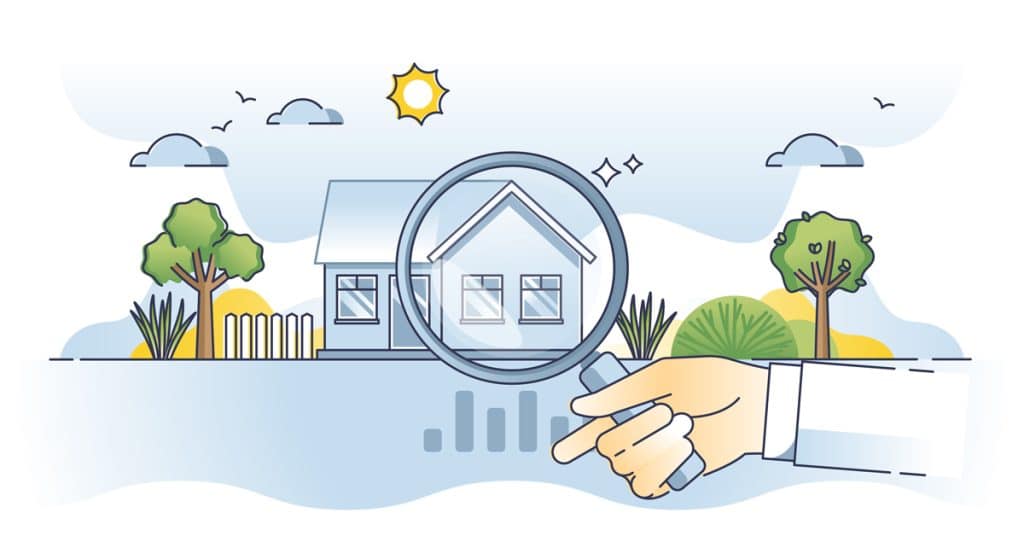
This is a very relevant and important question to consider when getting a loan to build a custom home since lenders will typically only loan a percentage, usually 80-85%, of the appraised value of the property. The question has become even more important as record inflation has impacted the construction industry over the last few years, driving labor and material prices to historical (if not ridiculous) levels.
First, let’s define “the property.” The property on which a lender will place a lien for the construction loan includes the vacant land and the improvements that are constructed on that land. Lenders will hire an appraiser (paid for by you in the closing costs of the loan) to value the property so they can determine how much money can be loaned to the homeowner. A licensed appraiser will place a value on the vacant land and the new home (the improvements) based on “comps,” or comparative properties that have sold recently in the nearby area. Here is an example:
If the property had been appraised for the true building costs, the loan amount would’ve been $600,000 ($125,000 + $625,000 = $750,000 x 80% = $600,000). The difference is an additional $100,000 the homeowner will have to come up with out of pocket. And herein lies the problem with custom home construction – the Appraisal Gap. Keep reading…
Appraisers use recent home sales, or comps, that have similar properties to the property the lender is considering for a loan. These comps, for the most part, are properties that have been sold through the Multiple Listing Service, or MLS (usually with the assistance of one or more licensed Realtors). Custom-built homes that were not listed and sold through the MLS are not typically available to be used as comps, nor are sales of existing homes that weren’t listed on the MLS (for-sale-by-owner, or FSBOs). Since appraisers don’t have official access to these custom home builds and “off-the-public-record” sales, they aren’t able to use the construction prices or sales prices as comps. This wasn’t always the case, but the financial crisis of 2008-2009 changed the rules that appraisers must follow to determine property values. These rule changes have been both good and bad, but I’m only going to focus on the Appraisal Gap as it relates to custom home values. The Appraisal Gap is not a good thing in my opinion.
In most cases, recent sales, or comps, are homes that were built years ago when relative construction prices were nowhere near what they are today. Comps on new homes are typically spec homes that were built with a different business model than ours: quality structure, energy efficiency, and mostly higher-end finishes and fixtures. To put it simply, homes that sell on the public market must be built for a low price to attract buyers. Something must give to achieve attractive market pricing. Most of these homes will not have foam insulation, quality windows, high efficiency air conditioning equipment, and tankless water heaters for instance. The ironic part of the appraisal equation and the resulting Appraisal Gap is that appraisers typically will not place much, if any, value on these “upgrades.” I place the word in italics because these items are not upgrades for my homes.
My homeowners do place a high value on these qualities, however, and this is the basic definition of the problem of the Appraisal Gap. Other items affecting the Appraisal Gap common to many custom home projects are extensive site prep, expensive retaining walls, long driveways and utility lines, expensive water wells and septic systems (compared to municipal utilities), engineered and piered foundations, higher-end finishes and fixtures, and the list goes on and on. The value of items associated with a custom-built home compared to other comps can be tens of thousands of dollars with basically no associated increase in the appraised value. Some might be familiar with a similar disparity – building a pool. A $70,000 pool might return 25% of that value from an appraiser if you’re lucky.
There is some good news for those who have owned their property for several years or more.
Increased property values have helped with the valuation gap in the cost of building a custom home. Increased value of vacant land has made up some of the difference in the Appraisal Gap. For those who have bought land recently, it just depends on how much they paid. Many people have overpaid for land in North Texas due to fear of loss in our hot real estate market. Of course, this only increases the Appraisal Gap with custom-home construction. Making the problem even worse is the new rule that took place on May 1, 2023 by the Federal Housing Finance Agency (FHFA) where higher credit score buyers will likely face an increased loan-level price adjustment (LLPA) fee for their loan.
What does the Appraisal Gap mean for custom home building? For those looking to build a quality custom home, they will more than likely have to come up with more money out of pocket to make up the lenders’ limits on their loan-to-value ratio. The Appraisal Gap is a problem that needs solutions from our lawmakers. In North Texas, there are many, many homes that are built off the MLS record, and in my opinion, these homes comprise a significant percentage of the overall construction market in our area, if not the nation. If these homes make up a significant part of the market, why wouldn’t appraisers be able to use the values that homeowners are willing to pay for quality construction? Isn’t that the very definition of a market? Sadly, those non-MLS homes won’t be able to be used as comps until they are eventually sold through the MLS. In the case of most of my homeowners, this may be 20 or more years down the road.
For the record, I have cited no official sources for the content of this article. I have presented information based on my 25 years of building custom homes, my relationships and conversations with lenders and appraisers, and my experience with the issues caused by the Appraisal Gap.

For more information on building your new home in the North Texas area, please head to our Contact Us page and I will personally get back with you as soon as possible.
Will Steed, President of Will Steed Homes, Inc.


